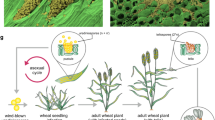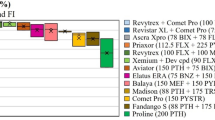Abstract
Tilletia indica, the fungus responsible for Karnal bunt disease of wheat, is currently recognised as a quarantine pest by both the EU and EPPO. The evidence that has been used to justify this status is reviewed and found to be in need of reappraisal. Yield losses caused by the pathogen are insignificant and disease levels are rarely high enough to cause serious quality problems. The sole reason for its designation as an important quarantine pest would seem to lie in the serious implications for trade should the pathogen be detected in an exporting country. Since there is strong evidence to suggest that T. indica may not even establish in Europe, it would seem logical to reclassify the pathogen as the cause of a minor disease that is likely to have little quarantine significance for Europe. However, since most wheat-growing countries have strict quarantine regulations aimed at preventing the introduction of T. indica, this reclassification is unlikely to occur unless plant health authorities around the world can agree on a new status of reduced importance for T. indica that suits its actual potential as a pest.
Similar content being viewed by others
References
Anon. (1997). Tilletia indica. In I. M. Smith, D. G. McNamara, P. R. Scott, & M. Holderness (Eds.), Quarantine pests for Europe (2nd ed., pp. 938–943). Wallingford, UK: CAB International.
Anon. (2001). Guidelines for the notification of non-compliance and emergency action. International Standards for Phytosanitary Measures No. 13. Secretariat of the International Plant Protection Convention. Rome, Italy: Food and Agriculture Organization of the United Nations.
Anon. (2002). Unofficial Consolidation of the European Community Plant Health Directive 2000/29/EC as last amended by Commission Directive 2002/28/EC (of 19 March 2002). Brussels, Belgium: Commission of the European Communities, Directorate-General for Agriculture.
Anon. (2004). Pest risk analysis for quarantine pets including analysis of environmental risks and living modified organisms. International Standards for Phytosanitary Measures No. 11, Secretariat of the International Plant Protection Convention. Rome, Italy: FAO.
Anon. (2005). Karnal bunt: Revision of regulations for importing wheat. Washington, USA: Animal and Plant Health Inspection Service, United States Department of Agriculture [http://www.washingtonwatchdog.org/documents/fr/04/mr/03/fr03mr04–22.html].
Anon. (2006a). Glossary of phytosanitary terms. International Standards for Phytosanitary Measures No. 5, Secretariat of the International Plant Protection Convention. Rome, Italy: Food and Agriculture Organization of the United Nations.
Anon. (2006b). The WTO agreement on the application of sanitary and phytosanitary measures (SPS Agreement). Geneva, Switzerland: World Trade Organization [http://www.wto.org/english/tratop_e/sps_e/spsagr_e.htm].
Babadoost, M. (2000). Comments on the zero tolerance quarantine of Karnal bunt of wheat. Plant Disease, 84, 711–712.
Beattie, B. R., & Biggerstaff, D. R. (1999). Karnal bunt, a wimp of a disease—but an irresistible political opportunity. Choices, Second Quarter, 1999, 4–8.
Bedi, P. S., Singh, P. P., & Sohi, H. S. (1981). Detection of aflatoxin-producing isolates of Aspergillus flavus from the wheat grains infected with ‘Karnal’ bunt. Indian Journal of Ecology, 8, 302–305.
Bhat, R. V., Deosthale, Y. G., Roy, D. N., Vijayaraghavan, M., & Tulpule, P. G. (1980). Nutritional and toxicological evaluation of ‘Karnal’ bunt affected wheat. Indian. Journal of Experimental Biology, 18, 1333–1335.
Bhat, R. V., Rao, B., Roy, D. N., Vijayraghvan, & Tulpule, P. G. (1983). Toxicological evaluation of Karnal bunt wheat. Journal of Food Safety, 5, 105–111.
Bonde, M. R., Peterson, G. L., Schaad, N. W., Smilanick, J. L. (1997). Karnal bunt of wheat. Plant Disease, 81, 1370–1377.
Bonde, M. R., Prescott, J. M., Matsumoto, T. T., & Peterson, G. L. (1987). Possible dissemination of teliospores of Tilletia indica by the practice of burning stubble. Phytopathology, 77, 639.
Brennan, J. P., & Warham, E. J. (1990). Economic losses from Karnal bunt in Mexico. CIMMYT Economic Working Paper 90/02. El Batán, Texcoco, México: Centro Internacional de Mejoramiento de Maiz y Trigo.
Brennan, J. P., Warham, E. J., & Byerlee, D., (1992). Evaluating the economic impact of quality-reducing, seed-borne diseases: Lessons from Karnal bunt of wheat. Agricultural Economics, 6, 345–352.
Carris, L. M., Castlebury, L. A., & Goates, B. J. (2006). Nonsystemic bunt fungi – Tilletia indica and T. horridae: A review of history, systematics and biology. Annual Review of Phytopathology, 44, 113–133.
Dowell, F. E., Boratynski, T. N., Ykema, R. E., Dowdy, A. K., & Staten, R. T. (2002). Use of optical sorting to detect wheat kernels infected with Tilletia indica. Plant Disease, 86, 1011–1013.
Goates, B. J. (1988). Histology of infection of wheat by Tilletia indica, the Karnal bunt pathogen. Phytopathology, 78, 1434–1441.
Goates, B. J., & Jackson, E. W. (2006). Susceptibility of wheat to Tilletia indica during stages of spike development. Phytopathology, 96, 962–966.
Jatav, A. L., Singh, C. B., Khan, A. A., & Sachan, C. P. (2003). Effects of Karnal bunt disease infection on the germination, tillering and yield of wheat. Progressive Agriculture, 3, 145.
Jones, D. R. (2007). Arguments for a low risk of establishment of Karnal bunt disease of wheat in Europe. European Journal of Plant Pathology, doi: 10.1007/s10658-006-9097-1.
Joshi, L. M., Singh, D. V., Srivastava, K. D., & Wilcoxson, R. D. (1983). Karnal bunt – A minor disease that is now a new threat to wheat. The Botanical Review, 43, 309–338.
Marshall, D., Work, T. T., & Carvey, J. F. (2003). Invasion pathways of Karnal bunt into the United States. Plant Disease, 87, 999–1003.
McRae, W. (1934). Report of the imperial mycologist. Science Reports of the Imperial Institute of Agricultural Research, 1932–1933 (pp. 134–160). Pusa, India.
Mehdi, V., Joshi, L. M., & Abrol, Y. P. (1973). Studies on chapatti quality. VI. Effect of wheat grains with bunts on the quality of ‘chapatties’. Bulletin of Grain Technology, 11, 195–197.
Mitra, M. (1931). A new bunt of wheat in India. Annals of Applied Biology, 18, 178–179.
Munjal, R. L. (1975). Studies on Karnal bunt (Neovossia indica) of wheat in northern India during 1968–69 and 1969–70. Indian Journal of Mycology and Plant Pathology, 5, 185–187.
Murray, G. M., & Brennan, J. P. (1998). The risk to Australia from Tilletia indica, the cause of Karnal bunt of wheat. Australasian Plant Pathology, 27, 212–225.
Nagarajan, S., Aujla, S. S., Nanda, G. S., Sharma, I., Goel, L. B., Kumar, J., & Singh, D. V. (1997). Karnal bunt (Tilletia indica) of wheat – A review. Review of Plant Pathology, 76, 1207–1214.
Rush, C. M., Stein, J. M., Bowden, R. L., Riemenschneider, R., Boratyniski, T., & Royer, M. H. (2005). Status of Karnal bunt of wheat in the United States 1996 to 2004. Plant Disease, 89, 212–223.
Sansford, C., Baker, R., Brennan, J., Ewert, F., Gioli, B., Inman, A., Kelly, P., Kinsella, A., Leth, V., Magnus, H., Miglietta, F., Murray, G., Peterson, G., Porta-Puglia, A., Porter, J., Rafoss, T., Riccioni, L., Thornes, F., & Valvassoni, M. (2006). Deliverable Report DL 6.1. Report on the risk of entry, establishment and economic loss for Tilletia indica in the European Union. EC Fifth Framework Project QLKS-1999-01554 Risks Associated with Tilletia indica, the Newly Listed EU Quarantine Pathogen, the Cause of Karnal Bunt of Wheat [http://karnalpublic.pestrisk.net/].
Sekhon, K. S., Randhawa, S. K., Saxena, S. K., & Gill, K. S. (1981). Effect of washing/steeping on the acceptability of Karnal bunt infected wheat for bread, cookie and chapatti making. Journal of Food Science and Technology, 18, 1–2.
Shukla, D. N., Singh, N., & Bhargava, S. N. (1982). Wheat varieties affected by Karnal bunt. Vijnana Parishad Anusandhan Patrika, 25, 39–40.
Singh, D. (1980). A note on the effect of Karnal bunt on the vigour of wheat seed. Seed Research, 8, 81–82.
Singh, A. (1988). Epidemiology of Karnal bunt of wheat. In V. S. Malik & D. E. Mathre (Eds.), Bunts and smuts of wheat: an international symposium (pp. 149–162). Ottawa, Canada: North American Plant Protection Organization.
Singh, A. (1994). Epidemiology and management of Karnal bunt of wheat. Research Bulletin No. 127. Patnagar, India: G.B. Pant University of Agriculture and Technology.
Singh, D. V. (2005). Karnal bunt of wheat: A global perspective. Indian Phytopathology, 58, 1–9.
Singh, D. V., Srivastava, K. D., Aggarwal, R., & Jain, S. K. (1996). Factors associated with the development and spread of Karnal bunt of wheat (Triticum aestivum) in north western India. Indian Journal of Agricultural Science, 66, 374–383.
Stansbury, C. D., McKirdy, S. J., Diggle, A. J., & Riley, I. T. (2002). Modeling the risk of entry, establishment, spread, containment and economic impact of Tilletia indica, the cause of Karnal bunt of wheat, using an Australian context. Phytopathology, 92, 321–331.
Vocke, G., Allen, E. W., & Price, J. M. (2002). Economic analysis of ending the issuance of Karnal bunt phytosanitary wheat export certificates. Washington DC, USA: Wheat Yearbook/WHS-2002/March 2002, Economic Research Service, United States Department of Agriculture.
Warham, E. J. (1986). Karnal bunt disease of wheat: a literature review. Tropical Pest Management, 32, 229–242.
Warham, E. J. (1992). Karnal bunt of wheat. In U. S. Singh, A. N. Mukhopadhyay, J. Kumar, & H. S. Chaube (Eds.), Plant diseases of international importance (Vol. 1., pp. 1–24). New Jersey, USA: Prentice Hall.
Wilcoxson, R. D., & Saari, E. E. (Eds.) (1996). Bunt and smut diseases of wheat: Concepts and methods of disease management. El Batán, Texcoco, México: Centro Internacional de Mejoramiento de Maiz y Trigo.
Acknowledgements
Satvinder Kaur, Head of the Department of Plant Pathology, Punjab Agricultural University, Ludhiana and Robin Gogoi, Senior Scientist, Division of Plant Pathology, Indian Agricultural Research Institute, New Delhi are thanked for providing information on the current status of Karnal bunt in northwest India.
Author information
Authors and Affiliations
Corresponding author
Additional information
David Jones is a retired employee of the Central Science Laboratory (CSL). Statements and opinions expressed in this paper are those of the author and are not the views of the Central Science Laboratory.
Rights and permissions
About this article
Cite this article
Jones, D.R. A reappraisal of the current status of Tilletia indica as an important quarantine pest for Europe. Eur J Plant Pathol 118, 105–113 (2007). https://doi.org/10.1007/s10658-007-9133-9
Received:
Accepted:
Published:
Issue Date:
DOI: https://doi.org/10.1007/s10658-007-9133-9




